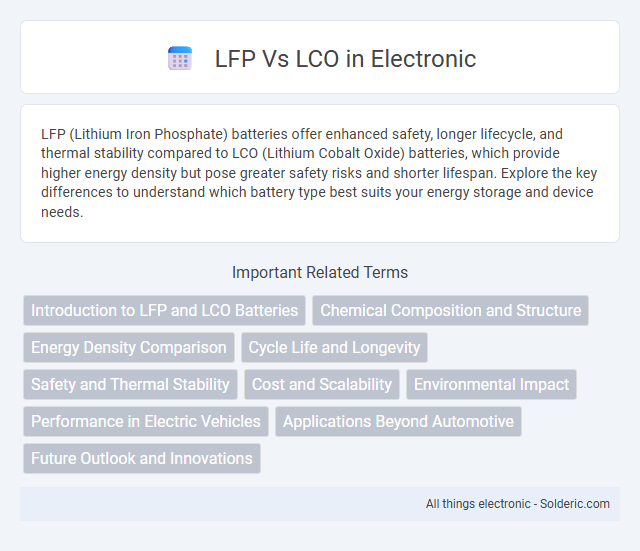LFP (Lithium Iron Phosphate) batteries offer enhanced safety, longer lifecycle, and thermal stability compared to LCO (Lithium Cobalt Oxide) batteries, which provide higher energy density but pose greater safety risks and shorter lifespan. Explore the key differences to understand which battery type best suits your energy storage and device needs.
Comparison Table
| Feature | LFP (Lithium Iron Phosphate) | LCO (Lithium Cobalt Oxide) |
|---|---|---|
| Chemistry | LiFePO4 | LiCoO2 |
| Energy Density | 90-160 Wh/kg | 150-200 Wh/kg |
| Cycle Life | 2,000+ cycles | 500-1,000 cycles |
| Thermal Stability | High, safer | Lower, more prone to overheating |
| Cost | Lower | Higher |
| Applications | Electric vehicles, energy storage, power tools | Smartphones, laptops, cameras |
| Voltage | 3.2-3.3 V nominal | 3.6-3.7 V nominal |
| Environmental Impact | Less toxic, easier recycling | More toxic cobalt, challenging recycling |
Introduction to LFP and LCO Batteries
LFP (Lithium Iron Phosphate) batteries are known for their stable thermal performance, long cycle life, and enhanced safety with reduced risk of overheating or fire. LCO (Lithium Cobalt Oxide) batteries offer high energy density and are widely used in consumer electronics due to their compact size and lightweight design. Both battery types utilize lithium-ion technology but differ significantly in chemical composition, performance characteristics, and application suitability.
Chemical Composition and Structure
Lithium Iron Phosphate (LFP) batteries contain a cathode composed of lithium iron phosphate (LiFePO4) with an olivine crystal structure, which provides enhanced thermal stability and longer cycle life. Lithium Cobalt Oxide (LCO) batteries feature a cathode made of lithium cobalt oxide (LiCoO2) with a layered rock-salt structure, offering high energy density but lower thermal stability. The olivine structure of LFP ensures safer operation and durability, while the layered structure of LCO enables higher voltage and capacity per cell.
Energy Density Comparison
LFP (Lithium Iron Phosphate) batteries typically offer an energy density of around 90-160 Wh/kg, while LCO (Lithium Cobalt Oxide) batteries range higher at approximately 150-200 Wh/kg. This difference makes LCO cells more suitable for applications where maximizing energy storage per weight is critical, such as in smartphones and laptops. Your choice depends on whether you prioritize energy density or other factors like safety and cycle life.
Cycle Life and Longevity
LFP (Lithium Iron Phosphate) batteries exhibit superior cycle life, often exceeding 3,000 to 5,000 charge-discharge cycles, compared to LCO (Lithium Cobalt Oxide) batteries, which typically endure around 500 to 1,000 cycles. The enhanced longevity of LFP stems from its stable phosphate chemistry, reducing capacity fade and thermal degradation over time. This makes LFP cells ideal for applications requiring long service life and consistent performance, such as electric vehicles and energy storage systems.
Safety and Thermal Stability
LFP (Lithium Iron Phosphate) batteries exhibit superior safety and thermal stability compared to LCO (Lithium Cobalt Oxide) batteries, due to their more stable chemical structure and lower risk of thermal runaway. LFP cells maintain consistent performance at higher temperatures and are less prone to overheating or catching fire, making them ideal for applications where safety is critical. Choosing LFP can enhance your device's durability and reduce hazards associated with battery failures.
Cost and Scalability
LFP (Lithium Iron Phosphate) batteries offer lower cost per kWh due to abundant raw materials and simpler manufacturing processes, making them highly scalable for large-scale applications like electric vehicles and grid storage. LCO (Lithium Cobalt Oxide) batteries, although having higher energy density, face higher costs because of expensive cobalt and complex production methods, limiting mass scalability. LFP's cost efficiency and material availability enable broader adoption and easier capacity expansion compared to LCO technology.
Environmental Impact
LFP (Lithium Iron Phosphate) batteries have a lower environmental impact compared to LCO (Lithium Cobalt Oxide) batteries due to the abundance and non-toxic nature of iron and phosphate. LCO batteries rely on cobalt, a rare and environmentally damaging metal to mine, leading to higher ecological and ethical concerns. Recycling LFP cells is often simpler and less hazardous, further reducing their overall environmental footprint.
Performance in Electric Vehicles
LFP (Lithium Iron Phosphate) batteries offer enhanced thermal stability and longer cycle life, making them ideal for electric vehicles requiring durability and safety. LCO (Lithium Cobalt Oxide) batteries provide higher energy density, which translates to longer driving range but can pose risks with overheating and shorter lifespan. Your choice depends on balancing performance priorities such as safety, longevity, and range in electric vehicle applications.
Applications Beyond Automotive
LFP (Lithium Iron Phosphate) batteries are widely utilized in stationary energy storage systems due to their long cycle life and enhanced thermal stability. LCO (Lithium Cobalt Oxide) batteries remain dominant in consumer electronics like smartphones and laptops, thanks to their high energy density and compact size. Industrial applications favor LFP for grid storage and backup power, while LCO serves portable medical devices and cameras where lightweight, efficient power sources are critical.
Future Outlook and Innovations
LFP (Lithium Iron Phosphate) batteries are gaining traction due to their enhanced safety, longer cycle life, and cost-efficiency, making them ideal for large-scale energy storage and electric vehicles (EVs) focused on sustainability. LCO (Lithium Cobalt Oxide) batteries will continue to serve high-energy-demand applications such as smartphones and laptops, benefiting from advances in cobalt supply chain sustainability and energy density improvements. Your choice between LFP and LCO should consider upcoming innovations like solid-state electrolytes, which promise to enhance energy density and safety across both chemistries.
LFP vs LCO Infographic

 solderic.com
solderic.com